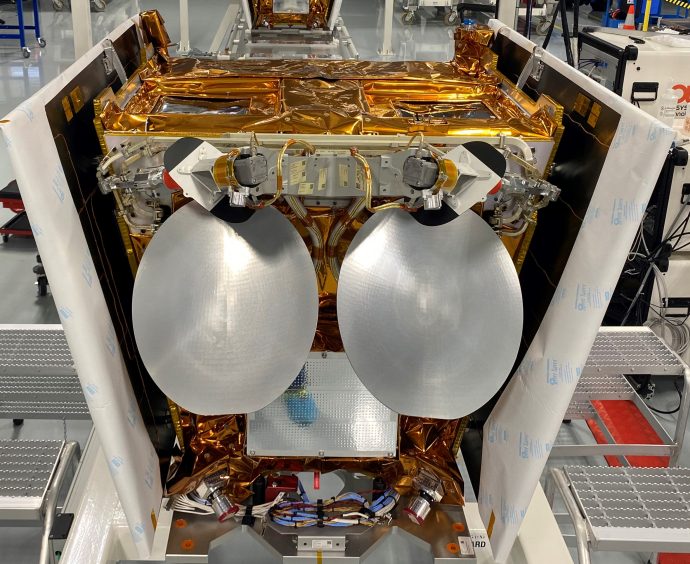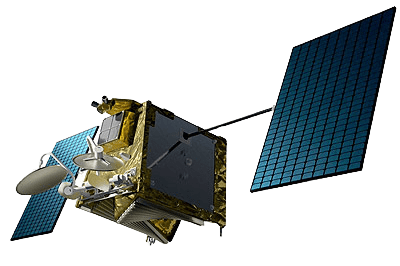The live stream above details OneWeb’s satellite fleet in action. Each white dot represents one of the 648 satellites within the network and if you watch this for a few seconds you’ll see a subtle position shift as these navigate the globe. The green icons are representative of the live locations of the International Space Station (ISS) and the Chinese Space Station (CSS), also orbiting Earth.
OneWeb’s satellite fleet operates within Low Earth Orbit (LEO), roughly 1,200km above the Earth’s surface. Organised into 12 orbital planes, satellites travel in a polar orbit – from pole-to-pole – at a speed of 27,000 km/h. All OneWeb satellites are operational and each completes an orbit in roughly 109 minutes, totalling 13 orbits per day.
35th
Parallel North Coverage
648
Satellites
12
Orbital planes
How does the OneWeb satellite constellation work?
OneWeb’s satellite constellation operates using Ku-band and Ka-band frequencies, connecting satellites, user terminals, and ground stations. Devices connect via custom user terminals like the Kymeta u8 LEO, featuring LEO antennas that send data to one of OneWeb’s satellites orbiting above. Data is then swiftly beamed back to Earth, entering the web via satellite network portals and trusted gateways, ensuring rapid <70ms ping times and uninterrupted service. The result? Near real-time communications without timeouts, signal drops, or lags, regardless of location.

OneWeb Satellites
Approximately the size of a small washing machine and weighing just 150 Kgs, OneWeb’s Gen 1 satellites are remarkably cost and time efficient, to manufacture and launch. Using 16 beams, each satellite can cover an area the size of Alaska 663,300 mi² (1.718 million km²), delivering 7.2 Gbps and contributing to a cumulative usable capacity of 1.1Tbps. Using laser communication to facilitate direct satellite-to-satellite communication and increase overall bandwidth, these satellites can also adjust their orbital path, optimizing positioning for efficient communication and data transmission. Using solar panels to generate power, OneWeb satellites boast a 5 year lifespan.
- Orbital speed: 27,000 km/h
- Orbit duration: 109 minutes
- Orbits per day: 13
OneWeb: Truly Global Coverage
OneWeb’s high-speed, low-latency network now spans the 35th parallel north, providing crucial connectivity to regions encompassing Canada, southern Europe, and the northern USA. This remarkable expansion achieved in May 2023 covers an additional 37 European countries, North America’s Western and Northeastern coasts, the expansive Midwest, Canada, and maritime regions. Additionally, the constellation’s convergence at the North Pole delivers enhanced capacity in this previously underserved area.
Having completed its launch program, OneWeb is advancing toward full global coverage by the end of 2023. As more of its 648 satellites reach their final position in the constellation, and additional ground stations are confirmed in strategic positions across the globe, services will continue to expand.
OneWeb’s versatile and reliable service, boasting low latency and high throughput connectivity, spans applications on land, at sea, and in the air. Delivering high-speed broadband connectivity to areas where viable alternatives may be scarce, affirms OneWeb’s commitment to bridging digital divides and enabling seamless communication experiences.

OneWeb: The LEO Advantage
One benefit of the OneWeb Low-Earth-Orbiting (LEO) satellites is the potential of low-latency or ping times. As OneWeb satellites orbit at an LEO altitude of 1,200km – which is 30 times closer to Earth than GEO satellites orbiting altitudes of 35,000km. This means latency is 5 to 10 times less, and currently the OneWeb network boasts latency as low as 70ms, while GEO latency can be as much as 560ms.
This reduction in latency brings forth benefits across various applications. Interactive live streaming, cloud-based applications, disaster recovery communications, voice calls and more all experience enhanced performance within the OneWeb network’s low-latency environment.
OneWeb vs Starlink
We’re often asked how OneWeb compares with Starlink and simply, while both share similar frequency bands and latencies, their target markets differ. Starlink aims to serve all sectors, including consumers, businesses, and government, offering lower-cost plans. OneWeb, in contrast, prioritizes reliable high-speed satellite services for private businesses and government agencies, ensuring more predictable network performance, albeit at slightly higher costs. The below table details some technical specifications individuals may find helpful.
Feature |
OneWeb |
Starlink |
|---|---|---|
| Orbital Altitude | 1,200 km | 550 km |
| Download Speed | Up to 150 Mbps | Up to 220 Mbps |
| Upload Speed | Up to 30 Mbps | Up to 20 Mbps |
| Latency | <70 ms | <25 ms Fixed | <60 ms Mobile |
| Number of Satellites | 648 | 4,519 in orbit | 4,487 operational |
NB: Above figures correct as of 8th August 2023.
The differences transcend technical specifications, with distinct approaches extending to hardware, partnerships, and security. Starlink maintains end-to-end control, meaning users have limited hardware choice and support, while OneWeb collaborates with established satellite antenna manufacturers, offering flexibility in form factors and performance. OneWeb empowers businesses and government agencies with greater control over traffic and security, facilitated via their service partner network, allowing personalized plans and direct technical support.
OneWeb doesn’t compete as a consumer network. Instead, it excels as a choice for businesses and government agencies seeking robust, reliable low latency, high-speed satellite internet. To explore tailored solutions, reach out to our experienced team at hello@groundcontrol.com, or for more information see our OneWeb service overview.

OneWeb Gen 2
In May 2023, OneWeb announced its fourth successful satellite launch in collaboration with SpaceX, 19th successful launch overall. This launch carried 16 satellites including JoeySat – a demonstration satellite for previewing OneWeb’s next-generation capabilities. JoeySat, nicknamed on account of new beam-hopping technologies was created through the European Space Agency and UKSA Sunrise Partnership programme. Its advanced payload design showcases digital regenerative processing, electronically steered multi-beam arrays, and pivotal digital beamforming technologies. In short, these capabilities will ensure OneWeb’s next generation can deliver more flexibility and capacity to customers, optimizing resources to manage real-time surges in demand and better enabling rapid responses to emergencies, e.g. in the case of a natural disaster.
Moreover, JoeySat is also a vital component of the end-to-end system validations, including 5G pilot tests. OneWeb’s Gen 2 constellation hopes to move closer to a fully interoperable network; integrating space and ground assets, to enable seamless backhaul to support 5G connectivity.
Also on board JoeySat is a radiation monitor which will measure and monitor the radiation environment in LEO, providing critical information for future missions and the scientific community.
Leveraging OneWeb's Airtime
Ground Control partners with leading manufacturers responsible for the design and creation of user terminals that leverage OneWeb airtime, including Kymeta and Hughes. These partners have worked with OneWeb to pioneer innovative flat panel terminals, which make global mobile connectivity a reality. Both the Kymeta u8 and Hughes LEO terminals boast phased array antennas, meaning there are no moving parts, and can deliver high-speed broadband internet on the move. The Kymeta u8 LEO terminal stands out for its user-friendly installation and nominal power consumption – less than 100W – and has already proved popular among our customers.
Since user terminals play a pivotal role in determining data speed and volume, we recommend discussing your unique application requirements and challenges with our expert team. For tailored, impartial advice contact us at hello@groundcontrol.com.

Are you researching options for your satellite connectivity project?
Call or email us, or complete the form and one of our expert team will get in touch.

